CORPO VIRTUALE VERSUS CORPO REALE
DOI:
https://doi.org/10.24193/theol.cath.var.2021-2022.17Keywords:
body, real, virtual, inforg, metaverse, digital, dignity, parallel worldsAbstract
Virtual Body versus Real Body. The opposition between body and self-perception lies at the heart of the problem concerning the relationship between the real and the virtual. The underlying problem, in the current contrast between the virtual and the real, stems from the great epochal change in which we are still fully engaged. Before, computers were computational tools, capable of processing data to facilitate decisions. Today, we are at the point where the information channel has come to constitute a virtual environment in which humans communicate, relate and act, an environment constituted by the so-called "inforg", i.e. informational agents capable of receiving, processing and emitting information. Trying to distinguish the real world from the virtual world, we come close to separating them, as if they were two parallel worlds; the truth is that both coexist in reality, they certainly having different consistency. Nevertheless they are inhabited by the same people, they communicate closely with each other, and often what happens in one has repercussions in the other. There are two ways of involving the body in the virtual: the associative and the dissociative way. The associative one tends to center the concrete and fully experiential reality, in which the body is the first aspect, while in the dissociative one the virtual world tends to deform the body or even deny it. The real problem today is not to define the existence of a digital society, but to begin to understand it and make it understood, to use the rules and values to build at least a little better a world, by being aware of the value and the dignity of our body.
Downloads
Published
How to Cite
Issue
Section
License
Copyright (c) 2022 Studia Universitatis Babeș-Bolyai Theologia Graeco-Catholica Varadiensis

This work is licensed under a Creative Commons Attribution-NonCommercial-NoDerivatives 4.0 International License.



